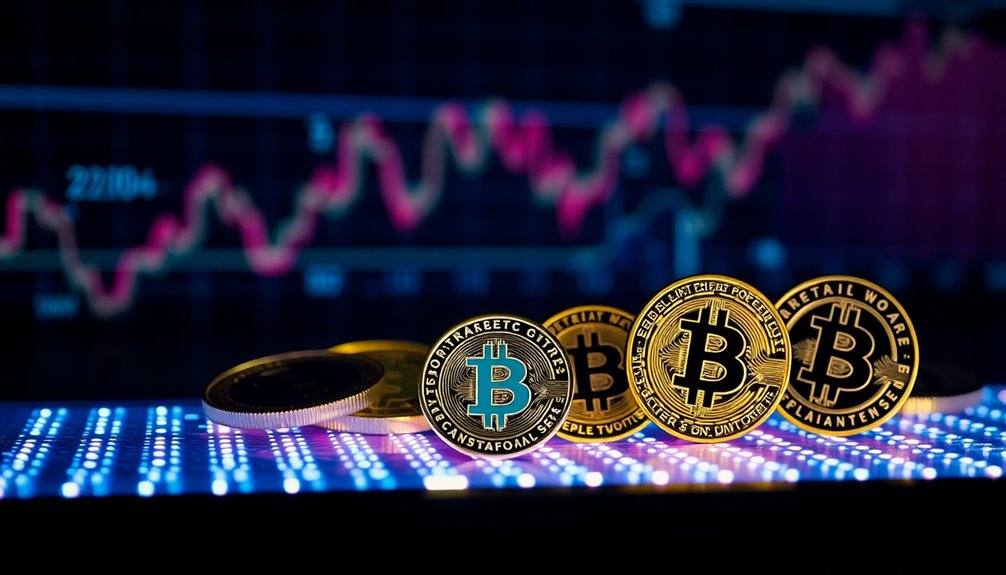Tokenomics is the blend of tokens and economics that defines how digital assets function in the cryptocurrency landscape. It involves key elements like token supply, distribution, and utility, which impact a project's success. You've got total supply, which sets a maximum limit, and circulating supply, indicating what's available for trading. A well-structured tokenomics strategy can enhance demand and stabilize prices, while poorly designed systems might lead to market volatility. Understanding these dynamics is vital for anyone engaging in crypto. Keep exploring, and you'll uncover even more insights into this intricate world.
Key Takeaways
- Tokenomics combines tokens and economic principles to define the functionality and value of digital assets in the cryptocurrency ecosystem.
- Key elements include token supply, distribution methods, governance, and transparency which collectively influence a project's success.
- Token supply mechanics involve total supply, circulating supply, and inflationary or deflationary models impacting token value and scarcity.
- Effective tokenomics can enhance sustainability and demand, while poorly designed systems may lead to volatility and market manipulation.
- Regulatory compliance is crucial, with varying frameworks affecting token classification, trading, and legal obligations across different jurisdictions.
Tokenomics Fundamentals Explained

Tokenomics is the backbone of cryptocurrency value, combining the concepts of tokens and economics to explain how these digital assets function.
It's crucial to understand token supply, which refers to the total number of tokens created for a project. The maximum token supply defines the cap on how many tokens will ever exist, like Bitcoin's 21 million limit.
On the other hand, token distribution affects how these tokens are allocated among users, which can influence their value and utility. A well-structured tokenomics model balances these elements, encouraging users to hold and utilize tokens rather than speculate.
If poorly designed, however, it can lead to volatility and uncertainty, undermining the project's success and appeal to long-term investors.
Tokenomics: Key to Success

When you understand the intricacies of tokenomics, you unlock the potential for a cryptocurrency to thrive. Token economics plays a crucial role in shaping the value and stability of digital assets.
A well-crafted token supply strategy can create scarcity, driving demand and encouraging investors to buy and hold. Smart token distribution methods, like vesting periods, foster community engagement and ensure fair access, which can enhance market dynamics.
Effective governance, often supported by governance tokens, empowers holders to make informed decisions that stabilize the project's economic environment.
Finally, transparency in tokenomics builds trust among stakeholders, which is essential for long-term success. By focusing on these elements, you position yourself for a more promising venture in the crypto space.
Token Supply Mechanics Explained

Understanding token supply mechanics is crucial for navigating the cryptocurrency landscape effectively. You need to grasp the differences between total supply, circulating supply, and maximum supply.
Total supply refers to the maximum number of tokens that can ever exist, like Bitcoin's cap of 21 million coins. On the other hand, circulating supply indicates how many tokens are available for trading at any moment.
Some projects, like Dogecoin, embrace an inflationary model with unlimited supply, continuously issuing new tokens. In contrast, deflationary models, such as Ethereum's transaction fee-burning, reduce supply and potentially increase the value of remaining tokens.
Pros and Cons Summary

While navigating the complexities of tokenomics, you'll find both advantages and drawbacks that can significantly impact your investment decisions.
On the positive side, effective tokenomics enhances project sustainability by creating incentives for users to buy and hold tokens, which can drive demand and elevate prices. It also fosters community engagement through transparent token distribution and governance, allowing stakeholders to influence project decisions.
However, poorly designed tokenomics can lead to market volatility and rampant speculation, often seen with memecoins. Additionally, concentrated token distribution can cause price fluctuations and manipulation risks, as a few holders control a significant portion of the supply.
Lastly, a lack of clear utility for tokens can reduce investor interest, jeopardizing the project's viability.
Token Utility Versus Distribution

Effective tokenomics hinges not only on the pros and cons of its design but also on the interplay between token utility and distribution.
Token utility refers to the specific functions a token provides, like governance rights or transaction fee discounts, driving demand and enhancing its market value.
Meanwhile, the distribution of tokens affects how they're allocated among stakeholders, impacting ownership concentration and market dynamics. A fair distribution strategy fosters community engagement and stability, while uneven ownership can lead to volatility and eroded trust.
Hence, a highly useful token might struggle if it's held by a small group.
Successful projects clearly define token utility and pair it with a transparent distribution plan to build investor confidence and encourage long-term participation.
Regulatory Compliance Issues

As the landscape of tokenomics evolves, navigating regulatory compliance issues becomes crucial for projects aiming to thrive. You need to understand that regulatory frameworks governing token issuance and trading vary significantly across jurisdictions.
In the U. S. , the SEC classifies certain tokens as securities, which means your project must meet specific registration requirements that could impact its utility. Additionally, implementing Know Your Customer (KYC) and Anti-Money Laundering (AML) regulations is vital to prevent illicit activities and ensure transparent token distribution. Failure to comply with these regulations can lead to significant fines and legal repercussions for the project founders. Furthermore, understanding how to navigate the intricacies of the SEC’s classifications is essential for maintaining the legitimacy and longevity of a token project. To facilitate this, resources such as ‘erc20 token standards explained‘ can provide valuable insights into the technical and regulatory frameworks that govern token issuance and management.
You also have to consider complex tax implications, as different countries treat cryptocurrency transactions differently. Non-compliance can lead to severe penalties, including fines or shutdowns, highlighting the necessity of establishing clear legal frameworks within your tokenomics strategy.
Emerging Defi Token Models

Emerging DeFi token models are revolutionizing the way users interact with decentralized finance, introducing innovative mechanisms that enhance participation and rewards.
One key feature is liquidity mining, where you earn tokens by providing liquidity to decentralized exchanges (DEXs). This incentivizes your involvement in the ecosystem and aligns community interests through governance tokens, which let you vote on crucial protocol decisions.
Additionally, protocols like Uniswap and Aave utilize dynamic fee structures to maximize revenue for liquidity providers. You can also engage in yield farming by staking tokens in liquidity pools, boosting capital efficiency.
Finally, token burns and deflationary mechanisms create scarcity, potentially driving up token value over time, making these models an exciting part of the evolving tokenomics landscape.
Token Liquidity Management Techniques

In the rapidly evolving landscape of DeFi, managing token liquidity is key to ensuring smooth trading experiences and overall market stability.
You can enhance token liquidity management through various techniques. Utilizing liquidity pools allows decentralized exchanges (DEXs) to maintain efficiency, as these pools ensure a constant supply of tokens for trading.
Automated market makers (AMMs) facilitate this process, eliminating the need for traditional order books. Liquidity mining encourages users to contribute to these pools, rewarding them with additional tokens, thus boosting overall liquidity.
Furthermore, implementing dynamic fee structures can adapt to market conditions, promoting trading during high demand.
Lastly, token buybacks and burns help stabilize the market by reducing circulating supply, increasing demand, and potentially raising prices.
Frequently Asked Questions
What Is an Example of Tokenomics?
When you think of tokenomics, consider Bitcoin's example. Its maximum supply cap of 21 million coins creates a sense of scarcity, which influences its value.
You might also look at Ethereum, where transaction fee burning reduces circulating supply, potentially increasing value over time.
Then there's Binance Coin, which uses a token burn mechanism to cut total supply.
These examples show how tokenomics can impact a cryptocurrency's market dynamics and value.
What Is Ethereum Tokenomics?
Did you know that Ethereum's initial supply was around 72 million ETH?
In Ethereum's tokenomics, there's no maximum supply cap, allowing continuous issuance of ETH for transaction fees and smart contracts.
With the EIP 1559 fee-burning mechanism, a portion of transaction fees gets burned, making ETH more deflationary.
Plus, Ethereum 2.0's staking rewards incentivize you to lock up your ETH, enhancing network security while reducing the circulating supply.
How Do You Calculate Tokenomics?
To calculate tokenomics, you start by analyzing the total supply and circulating supply of the token.
You can find the market capitalization by multiplying the current price by the circulating supply. For fully diluted market cap, use the total supply instead.
Examine the inflation rate by looking at new tokens generated over time.
Additionally, evaluate token distribution to understand allocation strategies, and explore token utility to gauge its demand within the ecosystem.
What Is Tokenomics for Crypto Games?
You might think tokenomics is just a buzzword, but it's essential for understanding crypto games.
In these games, tokenomics shapes how in-game tokens are distributed, used, and valued. It impacts your engagement and the game's sustainability, influencing rewards and governance.
By grasping the economic model, you can make smarter decisions, whether you're playing for fun or investment.
Ultimately, a solid understanding enhances your overall gaming experience and potential rewards.
Conclusion
In exploring tokenomics, you've unlocked a powerful tool that can shape the future of your investments. Just as tokens create value in a decentralized world, your choices can lead to unexpected rewards. By understanding supply mechanics and utility versus distribution, you're not just participating; you're influencing an evolving landscape. Embrace these insights, and remember: every decision you make can align with broader trends, connecting you to a community that's as dynamic as the tokens themselves.









